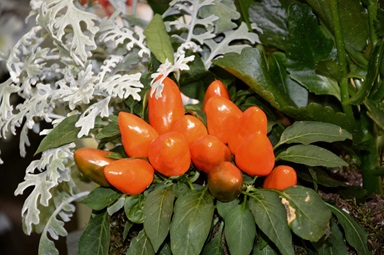Grow Vegetables In A Flower Garden
Flower gardens are an ideal place to grow vegetables. You can have a diverse and bountiful vegetable-flower garden even with limited space.
Mixing flowers and vegetables can attract beneficial insects, such as pollinators and pest-eating bugs and critters. This natural pollination and pest control can provide a healthy environment for vegetables and flowers.
Many vegetables can be considered for growing in the flower bed, but some are more ideal than others. Your choices will depend on the space and conditions of your unique garden.
Here are some practical ways to use a variety of vegetables to maximize yield while maintaining an attractive flower garden.
1. Tomatoes
Tomato plants are perfect summer plants for garden areas exposed to six or more hours of full sunlight.
Consider using indeterminate varieties. Regular pruning will keep plants from getting bushy as they continue producing fruit throughout the season.
Indeterminate varieties of tomatoes include Sweetie Pole Cherry Tomato, San Marzano Roma, Beefsteak Pole Tomato, and Moskvitch Pole Tomato.
Utilize vertical space by supporting indeterminate varieties with stakes or fencing.
Try mixing varieties for a diverse harvest. Enjoy the process, and don’t hesitate to experiment with different types that suit your taste!
2. Lettuce
The front border of your flower beds is an excellent place for quick-growing vegetables like lettuce. Lettuce, with its variety of types, can provide a fresh, leafy green component to your meals while also adding texture and color to your garden design.

Lettuce prefers to grow in cool weather but can be grown in heat with some strategy.
In spring, lettuce needs more sun in the cool spring than in the summer. Plant seeds so they get the most sun with cooler weather.
Lettuce can grow in partial shade, making it a versatile option for various garden setups.
Plant lettuce every couple of weeks to enjoy continuous harvests
3. Radishes
Radishes prefer to grow in cool weather so can be sown early in the season before other plants have begun to emerge, or later in the season as other plants begin to wind down. Radishes grow quickly, allowing for multiple plantings throughout the growing season and make great border plants or fillers.
Direct-sow radish seeds successively every week from earliest spring until late spring or early summer, then again in late summer and fall for autumn and early-winter crops.
Plant radishes every couple of weeks to enjoy on-going harvests.
4. Asparagus
Asparagus is a fantastic choice for your flower beds. It’s a perennial vegetable, meaning once planted, it will produce fresh spears year after year.
Asparagus can serve as both a food source and a decorative background in your flower beds.
Plant them once, and they will provide you with fresh spears each year. Their tall, fern-like summer growth makes for an attractive backdrop for other, shorter plants.
5. Beans
Snap beans or pole beans can be supported vertically or horizontally, utilizing space as is best for your situation. Successive planting will provide ongoing crops during summer.
Kentucky Wonder Pole Bean is a reliable space-saving pole bean that yield large harvests from white to purplish blooms and tolerates heat.
Trionfo Violetto Pole Bean produces violet-colored beans and has abundant lavender flowers that bloom against lush green leaves with purple veins and stems.
6. Peas
Peas prefer to grow in cool weather making them ideal for early spring planting. They are a great space-saving option as they climb upwards, making use of vertical space.
Using trellises or teepees, support peas early in the season. When the plants start to wind down, remove them and use the supports to grow pole beans or flowering annual vines.
7. Okra
Okra have a beautiful soft yellow flower that can enhance your flower garden and be a productive vegetable plant throughout the summer. Harvest often to ensure on-going production.

Clemson Spineless 80 Okra grows 4-5 ft tall and only 24” wide with green pods.
Red Burgundy Okra has crimson red okra pods on 4 foot plants. It’s a unique combination of red okra with yellow flowers.
Growing Okra is a perfect summer vegetable to add interest, color and practicality to the flower garden.
8. Peppers
Peppers are an ideal choice to incorporate into the summer flower bed. Consider all the shades of peppers and how they can add pops of color that work with the existing flowers and leaves. You may want to include both sweet and hot varieties. Look for compact varieties when space is limited.

See how nicely these bright orange peppers compliment the Dusty Miller growing next to it!
9. Beets and Carrots
Grow beets and carrots between flowering plants whether annuals or perennials. These root vegetables are ideal for fall planting and don’t require much space above ground, but will need space and depth below ground to develop.
Carrots and beets are cool weather crops, so plan for cool-season planting. Their leaves can replace spent annuals and revive the flower garden with color and unique texture.
Look for beet varieties that have red stems and red-veined leaves such as Detroit Dark Red Beet or Early Wonder Beet to add color and texture among perennials and annuals.
Carrots have a wide variety of sizes and colors to choose from, and their lacy leaves add unique texture to the garden. Plant in rows or groupings for late-season visual interest.
Explore More








Comments
Grow Vegetables In A Flower Garden — No Comments
HTML tags allowed in your comment: <a href="" title=""> <abbr title=""> <acronym title=""> <b> <blockquote cite=""> <cite> <code> <del datetime=""> <em> <i> <q cite=""> <s> <strike> <strong>